NVIDIA GeForce GTX 680 Review: Retaking The Performance Crown
by Ryan Smith on March 22, 2012 9:00 AM ESTCompute: What You Leave Behind?
As always our final set of benchmarks is a look at compute performance. As we mentioned in our discussion on the Kepler architecture, GK104’s improvements seem to be compute neutral at best, and harmful to compute performance at worst. NVIDIA has made it clear that they are focusing first and foremost on gaming performance with GTX 680, and in the process are deemphasizing compute performance. Why? Let’s take a look.
Our first compute benchmark comes from Civilization V, which uses DirectCompute to decompress textures on the fly. Civ V includes a sub-benchmark that exclusively tests the speed of their texture decompression algorithm by repeatedly decompressing the textures required for one of the game’s leader scenes. Note that this is a DX11 DirectCompute benchmark.
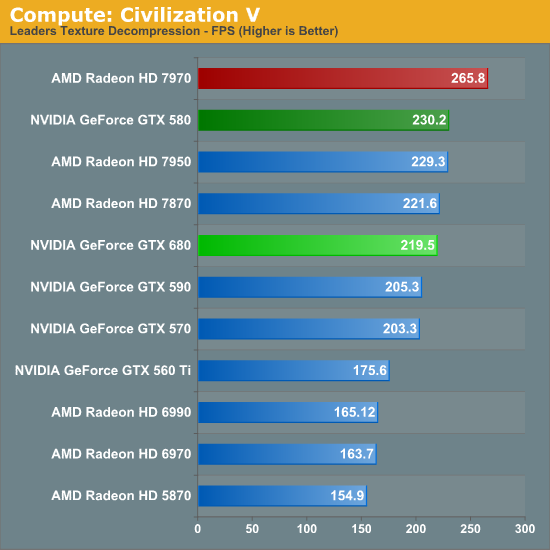
Remember when NVIDIA used to sweep AMD in Civ V Compute? Times have certainly changed. AMD’s shift to GCN has rocketed them to the top of our Civ V Compute benchmark, meanwhile the reality is that in what’s probably the most realistic DirectCompute benchmark we have has the GTX 680 losing to the GTX 580, never mind the 7970. It’s not by much, mind you, but in this case the GTX 680 for all of its functional units and its core clock advantage doesn’t have the compute performance to stand toe-to-toe with the GTX 580.
At first glance our initial assumptions would appear to be right: Kepler’s scheduler changes have weakened its compute performance relative to Fermi.
Our next benchmark is SmallLuxGPU, the GPU ray tracing branch of the open source LuxRender renderer. We’re now using a development build from the version 2.0 branch, and we’ve moved on to a more complex scene that hopefully will provide a greater challenge to our GPUs.
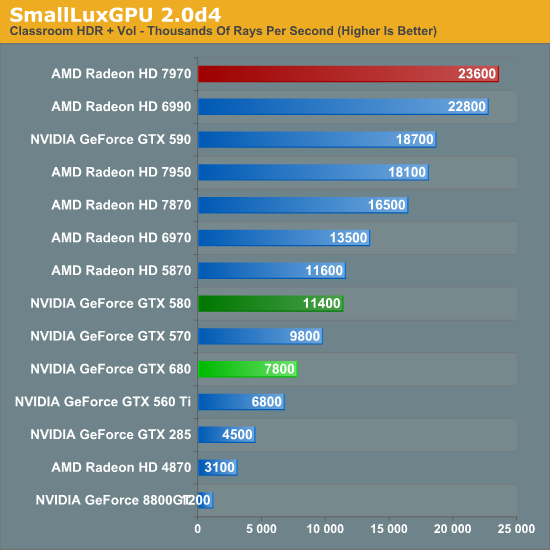
CivV was bad; SmallLuxGPU is worse. At this point the GTX 680 can’t even compete with the GTX 570, let alone anything Radeon. In fact the GTX 680 has more in common with the GTX 560 Ti than it does anything else.
On that note, since we weren’t going to significantly change our benchmark suite for the GTX 680 launch, NVIDIA had a solid hunch that we were going to use SmallLuxGPU in our tests, and spoke specifically of it. Apparently NVIDIA has put absolutely no time into optimizing their now all-important Kepler compiler for SmallLuxGPU, choosing to focus on games instead. While that doesn’t make it clear how much of GTX 680’s performance is due to the compiler versus a general loss in compute performance, it does offer at least a slim hope that NVIDIA can improve their compute performance.
For our next benchmark we’re looking at AESEncryptDecrypt, an OpenCL AES encryption routine that AES encrypts/decrypts an 8K x 8K pixel square image file. The results of this benchmark are the average time to encrypt the image over a number of iterations of the AES cypher.
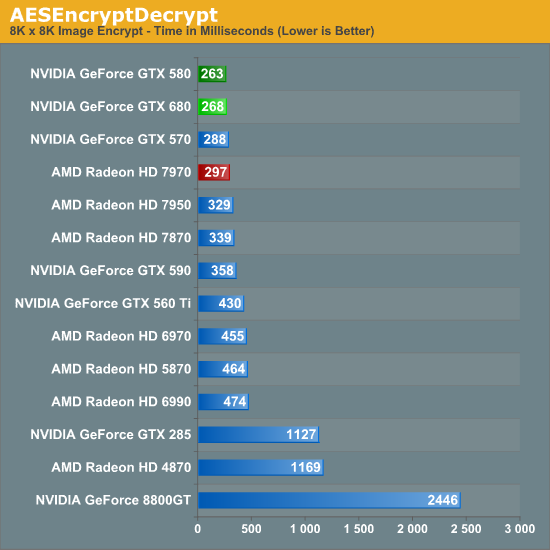
Starting with our AES encryption benchmark NVIDIA begins a recovery. GTX 680 is still technically slower than GTX 580, but only marginally so. If nothing else it maintains NVIDIA’s general lead in this benchmark, and is the first sign that GTX 680’s compute performance isn’t all bad.
For our fourth compute benchmark we wanted to reach out and grab something for CUDA, given the popularity of NVIDIA’s proprietary API. Unfortunately we were largely met with failure, for similar reasons as we were when the Radeon HD 7970 launched. Just as many OpenCL programs were hand optimized and didn’t know what to do with the Southern Islands architecture, many CUDA applications didn’t know what to do with GK104 and its Compute Capability 3.0 feature set.
To be clear, NVIDIA’s “core” CUDA functionality remains intact; PhysX, video transcoding, etc all work. But 3rd party applications are a much bigger issue. Among the CUDA programs that failed were NVIDIA’s own Design Garage (a GTX 480 showcase package), AccelerEyes’ GBENCH MatLab benchmark, and the latest Folding@Home client. Since our goal here is to stick to consumer/prosumer applications in reflection of the fact that the GTX 680 is a consumer card, we did somewhat limit ourselves by ruling out a number of professional CUDA applications, but there’s no telling that compatibility there would fare any better.
We ultimately started looking at Distributed Computing applications and settled on PrimeGrid, whose CUDA accelerated GENEFER client worked with GTX 680. Interestingly enough it primarily uses double precision math – whether this is a good thing or not though is up to the reader given the GTX 680’s anemic double precision performance.
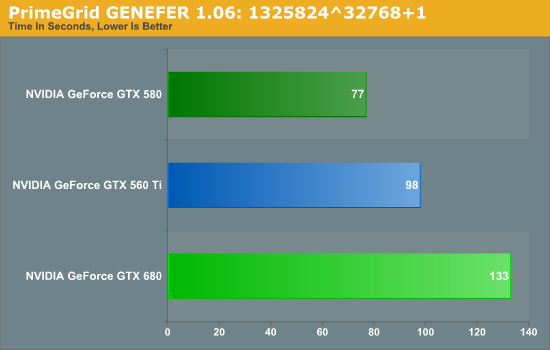
Because it’s based around double precision math the GTX 680 does rather poorly here, but the surprising bit is that it did so to a larger degree than we’d expect. The GTX 680’s FP64 performance is 1/24th its FP32 performance, compared to 1/8th on GTX 580 and 1/12th on GTX 560 Ti. Still, our expectation would be that performance would at least hold constant relative to the GTX 560 Ti, given that the GTX 680 has more than double the compute performance to offset the larger FP64 gap.
Instead we found that the GTX 680 takes 35% longer, when on paper it should be 20% faster than the GTX 560 Ti (largely due to the difference in the core clock). This makes for yet another test where the GTX 680 can’t keep up with the GTX 500 series, be it due to the change in the scheduler, or perhaps the greater pressure on the still-64KB L1 cache. Regardless of the reason, it is becoming increasingly evident that NVIDIA has sacrificed compute performance to reach their efficiency targets for GK104, which is an interesting shift from a company that was so gung-ho about compute performance, and a slightly concerning sign that NVIDIA may have lost faith in the GPU Computing market for consumer applications.
Finally, our last benchmark is once again looking at compute shader performance, this time through the Fluid simulation sample in the DirectX SDK. This program simulates the motion and interactions of a 16k particle fluid using a compute shader, with a choice of several different algorithms. In this case we’re using an (O)n^2 nearest neighbor method that is optimized by using shared memory to cache data.
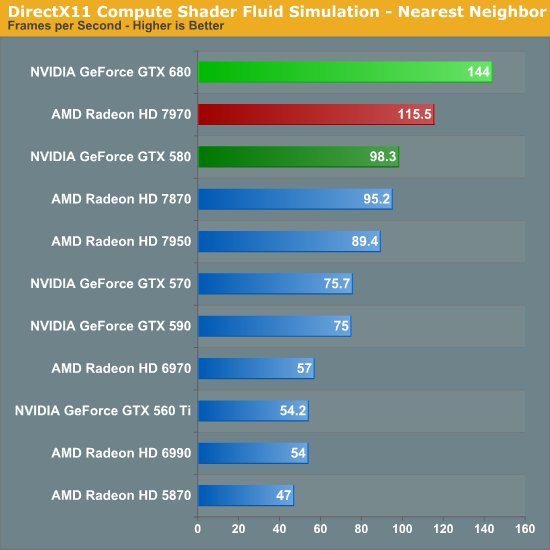
Redemption at last? In our final compute benchmark the GTX 680 finally shows that it can still succeed in some compute scenarios, taking a rather impressive lead over both the 7970 and the GTX 580. At this point it’s not particularly clear why the GTX 680 does so well here and only here, but the fact that this is a compute shader program as opposed to an OpenCL program may have something to do with it. NVIDIA needs solid compute shader performance for the games that use it; OpenCL and even CUDA performance however can take a backseat.










404 Comments
View All Comments
SlyNine - Friday, March 23, 2012 - link
lol, you're way of the mark.My point wasn't that the 680GTX isn't faster, it's however that it does stand up well against the 680GTX in performance.
As far as compute goes, I'm not sure I understand your premise. Frankly I think it's an invalid inference. I said kills it. If that somehow implies it means it losses in the other compute tests, I'm not sure how you got there. Again invalid inference of the data.
Galidou - Friday, March 23, 2012 - link
You didn't get the point of what he meant. Yes AMD is loosing but mostly in games that already run 60+fps. The games AMD wins is where it's still not maxed out yet(below 60 fps).Which maybe means if some big demanding games come out, the winning/loosing shceme might go back and forth. But right now, not much games out there will push those gpus unless you got very high resolutions and right now, I think 90% of gamers have 1080p and lower which still runs super smooth with 95% of graphical options enables on a 150$ GPU...
Still gotta say that this GTX 680 is really good for a flagship and the first one that's not uber huge and noisy and hot...
CeriseCogburn - Tuesday, March 27, 2012 - link
Shogun 2 TOTAL WAR, in this bench set is THE HARDEST GAME, not metro2033 and not crysis warhead.Sorry feller but ignoring that gets you guys the big fib you want.
Sorry.
CeriseCogburn - Tuesday, March 27, 2012 - link
SHOGUN 2 680 wins in top rez.from article " Total War: Shogun 2 is the latest installment of the long-running Total War series of turn based strategy games, and alongside Civilization V is notable for just how many units it can put on a screen at once. As it also turns out, it’s the single most punishing game in our benchmark suite"
OH WELL guess it's the metro2033 and crysis game engines cause the hardest game Nvidia 680 wins.
CeriseCogburn - Tuesday, March 27, 2012 - link
No you're WRONG. 1. 608 wins 1 bench in Merto2033, and ties within bench error on the other two resolutions.The hardest game as stated by the reviewer (since you never read) is Shogun2 total war, and Nvidia makes a clean sweep at all resolutions there.
In fact the Nvidia card wins everything but Crysis here, ties on Metro, and smokes everything else.
If Metro isn't a tie, take a look at the tie Ryan has for Civ5 and get back to me... !
(hint: Nvidia wins by far more in Civ5)
So--- let's see, one game with wierd benching old benching and AMD favored benchmark (dumping the waterfall bench that Nvidia won on all the time) >(Crysis)
One "tie" metro2033, then Nvidsia sweeps the rest of them. many by gigantic frame rate victories.
Other places show Nvidia winning metro2003 by a lot. (pureoverclock for one)
....
No I'm not the one fudging, spinning and worse. You guys are. You lost, lost bad, man up.
b3nzint - Monday, March 26, 2012 - link
gt680 got more clocks, way higher memory bandwidth than 7970 thats why it got lower power load and price. but i think we can only compare 2 things if they have the "same" engine like drag race cars. both of them made a big leap from previous tech. and thats a win for us.btw, who comes out first ..amd. i say amd win period. so next time maybe they must release next gen gpu on the same time.
b3nzint - Monday, March 26, 2012 - link
sorry what i meant was gtx 680 has lower memory, so it gain lower power.CeriseCogburn - Tuesday, March 27, 2012 - link
Or so a memory overclock unleashes it and it screams even further away at the tops of the charts...dlitem - Thursday, March 22, 2012 - link
Actual street prices can be different:At least here on the eastern shores of Atlantic ocean German retailers are selling 7970's starting 460-470 eur including taxes with cards on stock and GTX680's are starting 499eur with taxes...
TheRealArdrid - Thursday, March 22, 2012 - link
Sigh, are people really relying on that weak argument again? It's the same thing people said when Intel starting trouncing AMD: it's not fair because Intel has Turbo Boost.